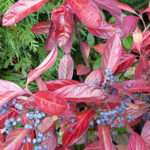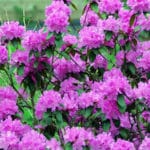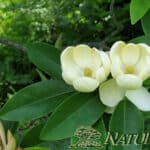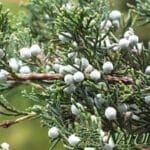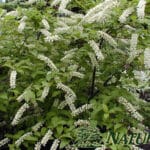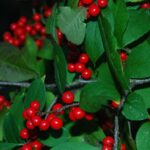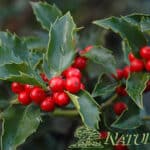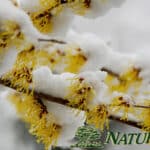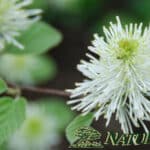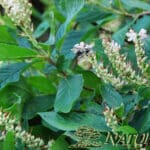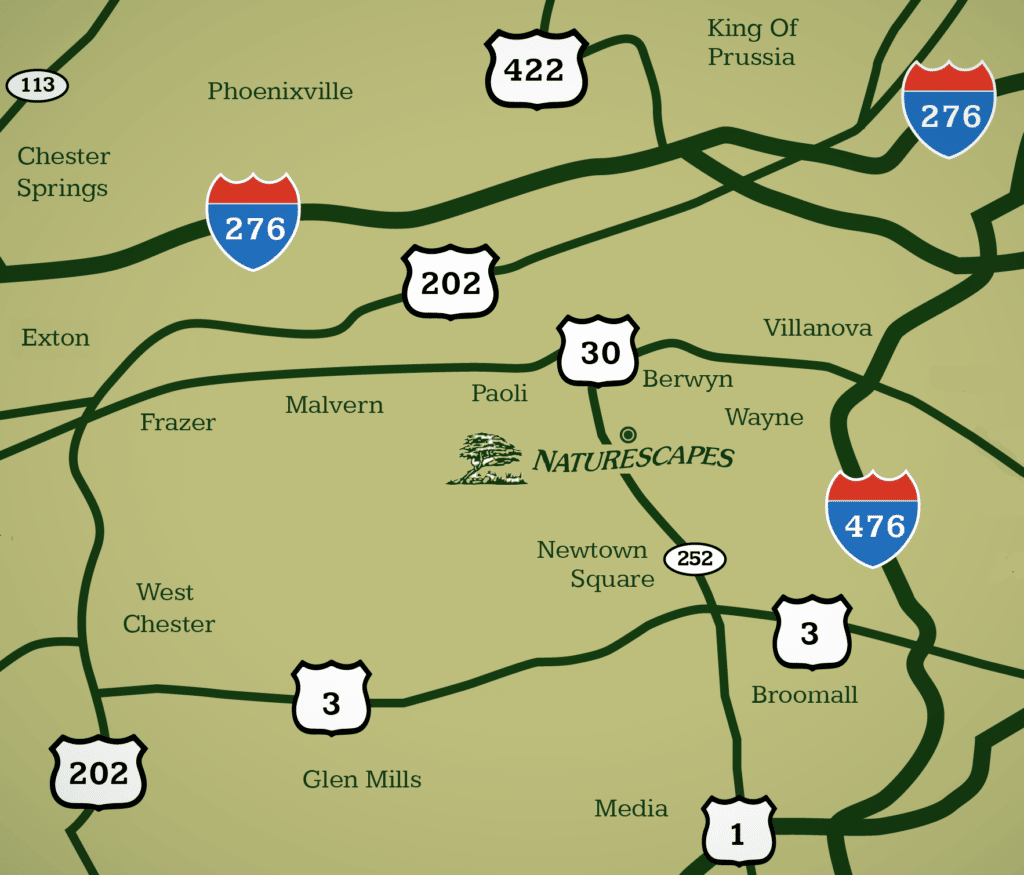After over 40 years of natural landscape design in Southeastern Pennsylvania, we have selected our 10 favorite native plants. Plants were chosen not just on beauty, but for lower maintenance, fragrance, beauty in all seasons, and ability to survive local pests and predators.
Viburnum nudum ‘Winterthur’
(Winterthur Viburnum)
Whereas most of the viburnums are terrific landscape plants with great displays of spring flowers and fall colors, this one really stands out.
Unlike most of its relatives, the Winterthur Viburnum stays quite small, 3-6’ tall with similar width. White 2-4” diameter flowers are borne in late spring, but the real show comes in fall with vibrant red foliage with bright blue berries which attract many songbirds.
Preferring full sun to part shade, it is adaptable to many soil types, even near streams or water.
With no known pests or predators – what’s not to loves about this viburnum?
Viburnum nudum ‘Winterthur’
Whereas most of the viburnums are terrific landscape plants with great displays of spring flowers and fall colors, this one really stands out.
Unlike most of its relatives, the Winterthur Viburnum stays quite small, 3-6’ tall with similar width. White 2-4” diameter flowers are borne in late spring, but the real show comes in fall with vibrant red foliage with bright blue berries which attract many songbirds.
Preferring full sun to part shade, it is adaptable to many soil types, even near streams or water.
With no known pests or predators – what’s not to loves about this viburnum?
Rhododendron P.J.M.
(P.J.M. Rhododendron)
The PJM Rhododendron is the easiest Rhododendron to grow. It is relatively small (5-6’ tall with similar spread) and some cultivars are even smaller. Its leaves are 2-3” long which are dusty green in the summer and become bronzed in fall through winter. It’s one of the first Rhododendron/Azaleas to bloom in the spring (late March to early April) with vibrant pink to purple blooms born on fist sized trusses at the ends of the branches.
In addition to its interesting color, the foliage has a pleasant spicy fragrance when rubbed, making it not predated by deer.
It can tolerate almost full sun, but would do better if it’s protected from the strong afternoon sun. Widely hardy and tolerates medium to light shade.
PJM Rhododendron is a cross between our native Carolina Rhododendron and Rhododendron dauricum from the Atlas Mountains in Central Asia. The PJM was named after Peter John Mezitt, the propagator’s father.
Rhododendron P.J.M.
The PJM Rhododendron is the easiest Rhododendron to grow. It is relatively small (5-6’ tall with similar spread) and some cultivars are even smaller. Its leaves are 2-3” long which are dusty green in the summer and become bronzed in fall through winter. It’s one of the first Rhododendron/Azaleas to bloom in the spring (late March to early April) with vibrant pink to purple blooms born on fist sized trusses at the ends of the branches.
In addition to its interesting color, the foliage has a pleasant spicy fragrance when rubbed, making it not predated by deer.
It can tolerate almost full sun, but would do better if it’s protected from the strong afternoon sun. Widely hardy and tolerates medium to light shade.
PJM Rhododendron is a cross between our native Carolina Rhododendron and Rhododendron dauricum from the Atlas Mountains in Central Asia. The PJM was named after Peter John Mezitt, the propagator’s father.
Magnolia virginiana
(Sweet bay Magnolia)
Most people are familiar with the introduced Magnolias that bloom in early spring, but this is a native that grows in coastal areas from Massachusetts to Florida and Texas.
In our area, this upright grower maxes out at about 20 feet with similar width. Its flower comes later in the season as a creamy white, yellow centered, lemon scented bloom that is scattered over the tree from May to June or longer.
The leaf is dark green with a silvery underside. The Sweet bay or Swamp Magnolia can handle wet sites and even shady conditions with no known pests or predators. This is a great small tree for fragrance and ornamentation.
Magnolia virginiana
Most people are familiar with the introduced Magnolias that bloom in early spring, but this is a native that grows in coastal areas from Massachusetts to Florida and Texas.
In our area, this upright grower maxes out at about 20 feet with similar width. Its flower comes later in the season as a creamy white, yellow centered, lemon scented bloom that is scattered over the tree from May to June or longer.
The leaf is dark green with a silvery underside. The Sweet bay or Swamp Magnolia can handle wet sites and even shady conditions with no known pests or predators. This is a great small tree for fragrance and ornamentation.
Juniperus virginiana
(Eastern Red Cedar)
This is a great evergreen native to the eastern and central US. It has a dense green habitat and is preferred by many bird species for nesting. The foliage is aromatic and only minimally abrasive to the touch. The fruit is showy, glaucus to brownish violet and is favored by a number of birds as food.
Eastern Red Cedar (really a juniper) loves full sun and open conditions and can tolerate a wide variety of soil conditions. Whereas the parent species can reach up to 50’ high and 15’ wide there are many varieties and cultivars that are well suited to the smaller landscape.
Two of my favorites are ‘Manhattan Blue’ and ‘Idyllwild’! Eastern Red Cedar can be used individually, as a windbreak or grouping. It can be predated by deer.
One caveat – as with all Junipers, one wants to avoid having them in combination with any apples or crabapples (malus) due to the cedar-apple rust fungi.
Juniperus virginiana (Eastern Red Cedar) at South Riding Golf Course in South Riding, Virginia photographed by Famartin
Juniperus virginiana
This is a great evergreen native to the eastern and central US. It has a dense green habitat and is preferred by many bird species for nesting. The foliage is aromatic and only minimally abrasive to the touch. The fruit is showy, glaucus to brownish violet and is favored by a number of birds as food.
Eastern Red Cedar (really a juniper) loves full sun and open conditions and can tolerate a wide variety of soil conditions. Whereas the parent species can reach up to 50’ high and 15’ wide there are many varieties and cultivars that are well suited to the smaller landscape.
Two of my favorites are ‘Manhattan Blue’ and ‘Idyllwild’! Eastern Red Cedar can be used individually, as a windbreak or grouping. It can be predated by deer.
One caveat – as with all Junipers, one wants to avoid having them in combination with any apples or crabapples (malus) due to the cedar-apple rust fungi.
Juniperus virginiana (Eastern Red Cedar) at South Riding Golf Course in South Riding, Virginia photographed by Famartin
Itea virginica
(Virginia Sweetspire)
A wonderful native plant that grows easily from the New Jersey Pine Barrens to Florida and west to Missouri.
Two superior varieties are ‘Henrys Garnet’ and ‘Little Henry’ that get to 4-5’ and 2-3’ respectively. These super hardy plants get long, pendulous white flowers in June and a spectacular russet-red fall leaf color.
They love wet sites but will be happy in dry soils, too. Virginia Sweetspires colonize (spreads) by stolons, but are easily contained if that is the desire. Sweetspire loves full sun as long as the soil is moist, but can take ½ day exposure, too.
There are no known pests or predators; however you will love this plant as much as the butterflies and other pollinators do.
Itea virginica
A wonderful native plant that grows easily from the New Jersey Pine Barrens to Florida and west to Missouri.
Two superior varieties are ‘Henrys Garnet’ and ‘Little Henry’ that get to 4-5’ and 2-3’ respectively. These super hardy plants get long, pendulous white flowers in June and a spectacular russet-red fall leaf color.
They love wet sites but will be happy in dry soils, too. Virginia Sweetspires colonize (spreads) by stolons, but are easily contained if that is the desire. Sweetspire loves full sun as long as the soil is moist, but can take ½ day exposure, too.
There are no known pests or predators; however you will love this plant as much as the butterflies and other pollinators do.
Ilex verticilatta
(Winterberry Holly)
Winterberry Holly is one of the very few deciduous Hollies that leaves stems full of red berries after the leaves fall off.
This native grows from eastern Canada to Alabama and loves wet sites, unlike most Hollies.
It gets tiny white flowers in June and are a favorite of pollinators. The berries start green and ripen to red (some varieties are orange) in August/September and persist into January depending on bird populations. These berries are a favorite food source for songbirds.
The multi-stemmed parent species can get 6-9’ tall while the dwarf species, ‘Sprite’ grow to about 3’.
Ilex verticillata is a terrific plant for the fall/winter landscapes with the added bonus of feeding pollinators and birds. Like most Hollies, Winterberry needs a male (along with a female) for good fruit set.
Ilex verticilatta
Winterberry Holly is one of the very few deciduous Hollies that leaves stems full of red berries after the leaves fall off.
This native grows from eastern Canada to Alabama and loves wet sites, unlike most Hollies.
It gets tiny white flowers in June and are a favorite of pollinators. The berries start green and ripen to red (some varieties are orange) in August/September and persist into January depending on bird populations. These berries are a favorite food source for songbirds.
The multi-stemmed parent species can get 6-9’ tall while the dwarf species, ‘Sprite’ grow to about 3’.
Ilex verticillata is a terrific plant for the fall/winter landscapes with the added bonus of feeding pollinators and birds. Like most Hollies, Winterberry needs a male (along with a female) for good fruit set.
Ilex meserveae
(Meserve Holly)
Meserve Hollies are also known as the Blue Hollies as their evergreen leaves have a bluish green color. They are a cross between two non-native shrubs created on Long Island. These shrub-like hollies are very cold tolerant and have good berry set as long as a male is planted nearby. Most hollies are separate-sexed and need a pollinating male of similar variety to be close at hand.
Meserve Hollies are sold as ‘Blue Girl’, ‘Blue Princess’, ‘Blue Maid’ and need a ‘Blue Boy’, ‘Blue Prince’ or ‘Blue Stallion’ respectively for good berry production.
These plants get to be about 5-8’ tall and broad and do well in most soils. They like good sun, but do best if protected from strong western sun and winter winds.
Sometimes the deer will eat them. Pollinators love this variety and all hollies.
Ilex meserveae
Meserve Hollies are also known as the Blue Hollies as their evergreen leaves have a bluish green color. They are a cross between two non-native shrubs created on Long Island. These shrub-like hollies are very cold tolerant and have good berry set as long as a male is planted nearby. Most hollies are separate-sexed and need a pollinating male of similar variety to be close at hand.
Meserve Hollies are sold as ‘Blue Girl’, ‘Blue Princess’, ‘Blue Maid’ and need a ‘Blue Boy’, ‘Blue Prince’ or ‘Blue Stallion’ respectively for good berry production.
These plants get to be about 5-8’ tall and broad and do well in most soils. They like good sun, but do best if protected from strong western sun and winter winds.
Sometimes the deer will eat them. Pollinators love this variety and all hollies.
Hamelelis virginiana x intermedia
(Witchazel)
There are several species in this genus that are native to the eastern US (from Canada to Georgia). Some have flowers that bloom in the mid-late winter and others bloom in the fall. All have strap-like small flowers of yellow, red or orange, some of which are quite fragrant.
Fall leaf color is very striking from dusty yellow to orange, yellow and red.
This is a tall growing shrub with height to 15 feet or more. One of my favorites is the ‘Arnold Promise’ that was propagated at the Arnold Arboretum. It has clear yellow, very fragrant flowers in mid-late winter which can last from 5-6 weeks.
A single cut branch which I recently brought indoors perfumed my kitchen for days.
The witchazels prefer a moist soil with good light and will tolerate a shaded location, but will have fewer blooms.
No known pests or predators.
Hamelelis virginiana x intermedia
There are several species in this genus that are native to the eastern US (from Canada to Georgia). Some have flowers that bloom in the mid-late winter and others bloom in the fall. All have strap-like small flowers of yellow, red or orange, some of which are quite fragrant.
Fall leaf color is very striking from dusty yellow to orange, yellow and red.
This is a tall growing shrub with height to 15 feet or more. One of my favorites is the ‘Arnold Promise’ that was propagated at the Arnold Arboretum. It has clear yellow, very fragrant flowers in mid-late winter which can last from 5-6 weeks.
A single cut branch which I recently brought indoors perfumed my kitchen for days.
The witchazels prefer a moist soil with good light and will tolerate a shaded location, but will have fewer blooms.
No known pests or predators.
Fothergilla major
(Fothergilla)
A terrific landscape shrub that is native to the Allegheny mountains and south. It has a midly fragrant white bottlebush flower from April to early May and spectacular fall coloration of orange, red and yellow.
To date, not predated by deer or insects, aside from very minimal munching.
Can range from 6-10 feet but dwarf forms (Fothergilla ‘Gardenii’) max at about 3 feet.
Fothergilla gardenii ‘Blue Mist’ has interesting frosty blue-green foliage in summer, but may have diminished fall color of the parent specias and other dwarfs.
Likes moist, somewhat protected location where it is protected from strong afernoon sun. Pollinators and early butterflies love Fothergilla.
Fothergilla major
A terrific landscape shrub that is native to the Allegheny mountains and south. It has a midly fragrant white bottlebush flower from April to early May and spectacular fall coloration of orange, red and yellow.
To date, not predated by deer or insects, aside from very minimal munching.
Can range from 6-10 feet but dwarf forms (Fothergilla ‘Gardenii’) max at about 3 feet.
Fothergilla gardenii ‘Blue Mist’ has interesting frosty blue-green foliage in summer, but may have diminished fall color of the parent specias and other dwarfs.
Likes moist, somewhat protected location where it is protected from strong afernoon sun. Pollinators and early butterflies love Fothergilla.
Clethra alnifolia
(Summersweet, Sweet Pepper Bush)
Summersweet is native from Maine to Florida. It can grow in swampy conditions to dry conditions and from full sun to ½ day exposure.
The flowers are a super fragrant white spire and bloom from July to August. The flowers then produce small pepper corn like seed heads which give the plant its other common name of Sweet Pepper Bush.
Fall color of the leaves is a lovely amber yellow for several weeks. Summersweet can get 6-8’ tall and 4’ or so wide. A tall variety that I like a lot is ‘Ruby Spire’ or ‘Rosea’ that has a fragrant pink flower.
A good dwarf form is ‘Sugartina’ which maxes at 3’ high. Butterflies, hummingbirds and pollinators love this plant and so will you.
Clethra alnifolia
Summersweet is native from Maine to Florida. It can grow in swampy conditions to dry conditions and from full sun to ½ day exposure.
The flowers are a super fragrant white spire and bloom from July to August. The flowers then produce small pepper corn like seed heads which give the plant its other common name of Sweet Pepper Bush.
Fall color of the leaves is a lovely amber yellow for several weeks. Summersweet can get 6-8’ tall and 4’ or so wide. A tall variety that I like a lot is ‘Ruby Spire’ or ‘Rosea’ that has a fragrant pink flower.
A good dwarf form is ‘Sugartina’ which maxes at 3’ high. Butterflies, hummingbirds and pollinators love this plant and so will you.
